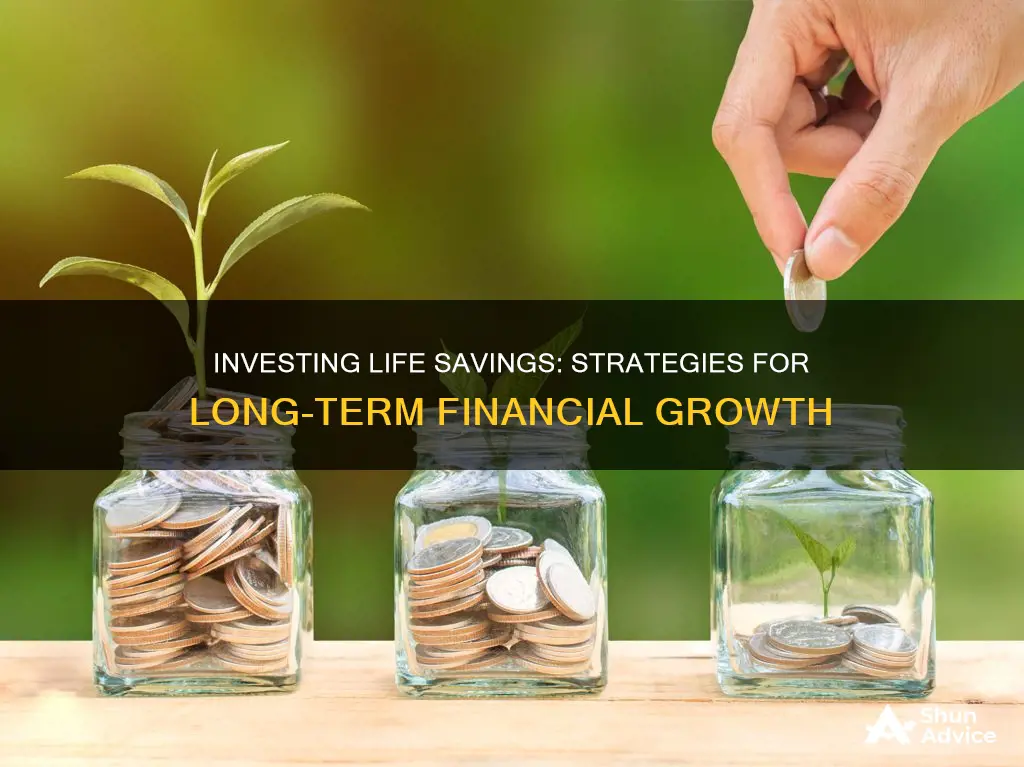
Investing your life savings can be a daunting prospect. It's important to understand the differences between saving and investing, and how they fit into your financial journey. Saving typically involves putting money into a low-risk, low-return account, such as a traditional or online savings account, money market account, or certificate of deposit. On the other hand, investing involves buying assets with the potential for higher returns and wealth growth, such as stocks, bonds, real estate, and more. When deciding whether to save or invest, factors such as time horizon, risk tolerance, and financial goals should be considered. For short-term goals and emergencies, saving is generally recommended, while investing is more suitable for long-term goals like retirement planning. It's also crucial to have an adequate emergency fund before investing.
| Characteristics | Values |
|---|---|
| When to save | If you don't have an emergency fund, need the cash within five years, or will need the cash in the near future |
| When to invest | If you are eligible for a 401(k) match, have a topped-up emergency fund, have paid off high-interest debt, or have long-term goals that will require a lot of cash |
| Pros of saving | Security, low risk, quick access to funds, ease of use |
| Cons of saving | Lower potential returns, potential for savings accounts to fail to keep up with inflation |
| Pros of investing | Potential for higher returns, many different access points and strategies, ability to buy into companies, industries, and sectors that interest you or that you support |
| Cons of investing | Less liquidity, potential to lose money, time-consuming, requires specialised knowledge, subject to biases and emotion-based decision-making |
What You'll Learn

Savings accounts vs investment accounts
Savings accounts and investment accounts are both important for building a sound financial foundation, but they are not the same thing. Saving typically results in lower returns with little to no risk, while investing allows for higher returns but with the risk of loss.
Savings Accounts
Saving involves putting money aside gradually, typically into a bank account, for a particular goal. This could include paying for a car, a down payment on a house, or building an emergency fund. Savings accounts can also include products such as bank time accounts (CDs) or money market accounts. Savings accounts are ideal for shorter-term goals, as they offer ready access to cash with minimal risk. Your funds are typically insured by the Federal Deposit Insurance Corporation (FDIC) up to $250,000 per depositor, and you can earn interest on your savings. However, savings accounts generally earn lower returns compared to investments.
When choosing a savings account, look for FDIC insurance, a high annual percentage yield (APY), and no monthly fee.
Investment Accounts
Investing, on the other hand, involves using your money to buy assets that will ideally increase in value, such as stocks, property, or shares in a mutual fund. Investing is typically done for longer-term goals, such as paying for a child's education or planning for retirement. While investing offers the potential for higher returns, it also comes with a higher level of risk. There is no guarantee of returns, and you may lose some or all of your investment.
When choosing an investment account, consider how hands-on you want to be and evaluate the fees and services offered by different brokerages.
When to Save vs. Invest
Financial advisors generally recommend prioritizing saving over investing if you don't have an emergency fund or if you'll need the cash within the next few years. It's important to have a financial cushion for unexpected expenses, typically recommended as three to six months' worth of living expenses.
You should also consider saving if you have high-interest debt, such as credit card balances. In this case, it's better to pay off the high-interest debt rather than invest, as the return on your investment may not outweigh the interest you're paying on the debt.
Investing is a good option if you're eligible for an employer match in your retirement account, such as a 401(k), as this is essentially free money. Investing is also ideal if you have long-term goals that will require a significant amount of cash, such as retirement or a college fund.
In summary, both savings and investment accounts have their advantages and should be used in conjunction to build wealth and achieve your financial goals. Savings accounts offer security and easy access to your money, while investment accounts offer the potential for higher returns over the long term.
Maximizing Your Savings Account: A Guide to Smart Investing
You may want to see also

Short-term vs long-term goals
When considering whether to invest your life savings, it's important to differentiate between short-term and long-term financial goals. Short-term goals are those you expect to achieve within a few months or years, while long-term goals are typically at least five years away. Here are some strategies for both:
Short-term goals
- Accessible, high-yield account: For short-term goals, choose an account that can be easily accessed when needed, such as a high-yield savings account or a money market account.
- Regular savings plan: Create a realistic savings plan to achieve your goal on time. This can be part of a monthly budget, where a certain amount of your income is set aside for savings.
- Automatic savings: Utilise mobile banking or fintech apps that offer automatic savings features. These apps can help you save a set percentage or dollar amount each month by transferring it to a connected savings account.
- Cut back on expenses: Look for areas in your budget where you can reduce spending temporarily. For example, cook meals at home instead of dining out or cancel unnecessary subscriptions.
Long-term goals
- Retirement account: Open a retirement account, such as an IRA or a 401(k), as early as possible to make it easier to reach your retirement savings goals.
- Separate accounts: Consider keeping your short-term and long-term savings in separate accounts to better track your progress for each goal. This can be especially helpful for specific long-term goals, such as saving for a child's education.
- Passive income opportunities: Explore passive income streams, such as investing in dividend stocks, creating a bond ladder, or selling homemade items online, to boost your long-term savings.
- Career advancement: Focus on long-term career strategies by finding fulfilling occupations that offer opportunities for growth and advancement. This can help you increase your income over time.
It's important to note that you should ideally work towards both short-term and long-term goals simultaneously. Additionally, having an emergency fund is crucial, and it should be prioritised before investing your life savings.
Invest Wisely: A Guide to Savings in Australia
You may want to see also

Risk tolerance
There are generally three types of risk tolerance: aggressive, moderate, and conservative. An aggressive investor has a higher risk tolerance and is willing to risk losing money to achieve potentially better results. They tend to be market-savvy and focus on capital appreciation rather than income preservation. Their investments usually emphasize stocks, with little to no allocation to bonds or cash. On the other hand, a conservative investor has a lower risk tolerance and seeks investments with guaranteed returns. They prefer investments with low volatility and commonly opt for bank certificates of deposit (CDs), money markets, or U.S. Treasuries. A moderate investor aims for a balanced strategy, seeking to grow their money while minimizing losses. Their portfolio typically includes a mixture of stocks and bonds, such as a 50/50 or 60/40 structure.
It's important to note that risk tolerance can change over time as an individual's age, financial situation, and life circumstances evolve. For example, retirees or those approaching retirement age often have a lower risk tolerance as they may be unwilling to risk losing their principal investment. Additionally, having a larger portfolio may increase an investor's tolerance for risk, as the percentage of loss is relatively smaller compared to a smaller portfolio.
When determining your risk tolerance, it's crucial to assess your financial situation, goals, and comfort level with risk. Ask yourself questions such as "Do I need the money I'm investing in the short or long term?" and "How would I react if my investment dropped significantly in value?". Online risk tolerance assessments and historical returns for different asset classes can also provide valuable insights.
By understanding your risk tolerance, you can make informed investment decisions, plan your portfolio, and navigate market volatility with less stress. It's important to remember that investing always carries some risk, and it's essential to balance that risk effectively to take advantage of long-term opportunities.
529 Savings Plans: Smart Investment Strategies, per Forbes
You may want to see also

Financial goals
Setting financial goals is an important step towards becoming financially secure. Without clear goals, you are likely to spend more than you should and will be unable to prepare for unexpected expenses.
Short-term Financial Goals
Short-term financial goals are those that can be achieved in a year or less. They include:
- Creating a budget and sticking to it.
- Building an emergency fund. Financial advisors recommend saving at least three months' worth of living expenses, but preferably six months' worth.
- Paying off credit card debt.
Mid-term Financial Goals
Mid-term financial goals are those that will take more than a year but less than a decade to achieve. They include:
- Getting life insurance and disability income insurance, especially if you have a spouse or children who depend on your income.
- Paying off student loans.
- Buying a home, starting a family, or saving for college expenses.
Long-term Financial Goals
Long-term financial goals are those that will take more than a decade to achieve. The most common long-term financial goal is saving enough money to retire. To estimate how much you need to save for retirement, you can use the following formula:
- Estimate your desired annual living expenses during retirement.
- Subtract the income you will receive from Social Security, retirement plans, and pensions.
- Estimate how much in retirement assets you need to cover the remaining expenses, based on what you currently have and are saving annually.
It is recommended that you save 10-15% of every paycheck in a tax-advantaged retirement account, such as a 401(k) or IRA.
General Tips for Saving and Investing
- It is generally recommended to prioritize saving over investing if you don't have an emergency fund or if you will need the cash within the next few years.
- If you have credit card debt, consider paying it off before investing, as the interest on credit card debt is usually higher than the returns you would get from investing.
- When choosing a savings account, look for one that has FDIC insurance, a high annual percentage yield (APY), and no monthly fee.
- When choosing a brokerage account for investing, consider how hands-on you want to be and whether you want to use a robo-advisor or a traditional brokerage.
- The amount of time you have to achieve your financial goals will affect how you plan to save and invest. For short-term goals, focus on building savings in low-risk accounts. For long-term goals, you may want to consider a broader range of investment types, including stocks, bonds, and index funds.
- Your comfort with risk depends on your emotional willingness to accept risk and your financial ability to absorb losses. This is known as your risk tolerance.
S-Corp Savings: Investing for Growth and Security
You may want to see also

Pros and cons of saving vs investing
Saving and investing are both important for building a sound financial future, but they are not the same thing. Saving typically results in lower returns but with almost no risk, while investing allows for higher returns but with the risk of loss. Here is a more detailed look at the pros and cons of saving vs investing:
Pros of Saving:
- The dollar amount in your bank account won't decrease unless you withdraw funds.
- You can safely rely on reaching your financial goals on time if you save the proper amount each month.
- Savings accounts are FDIC-insured for up to $250,000, so your money is guaranteed and safe.
- Bank products are generally very liquid, meaning you can access your money quickly in case of emergencies.
- Saving is generally straightforward and easy to do, with minimal fees and no upfront cost or learning curve.
Cons of Saving:
- Returns are low, meaning you could earn more by investing (but higher returns are not guaranteed).
- Due to low returns, you may lose purchasing power over time as inflation eats away at your money.
Pros of Investing:
- Investing products such as stocks can have much higher returns than savings accounts.
- Investing products are generally very liquid, and can easily be converted into cash.
- If you own a diversified collection of stocks, you are likely to beat inflation over the long term and increase your purchasing power.
- Investing gives your money the potential to grow faster than it could in a savings account, especially with compound interest.
Cons of Investing:
- Returns are not guaranteed, and there is a good chance you will lose money in the short term as asset values fluctuate.
- Depending on when you sell, you may not get back what you initially invested.
- Investing can be complex, and you will need to do some research and understand key investment concepts.
- Fees can be higher in brokerage accounts.
In summary, saving is generally the safer option if you need access to your money in the short term, while investing is better for longer-term goals as it provides the opportunity for higher returns. A robust financial plan includes both savings vehicles and long-term investments, and the transition from saving to investing should occur once you have amassed an adequate reserve of liquid assets.
Smart Ways to Invest Your RBFCU Savings
You may want to see also







